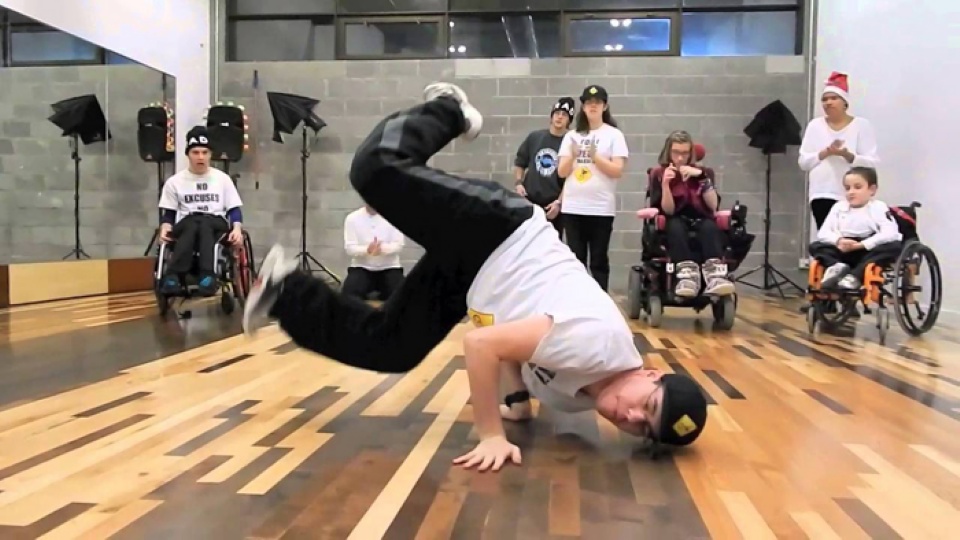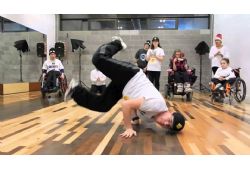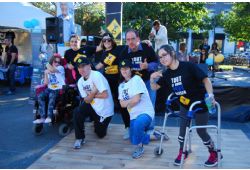Have
you ever had a dream; a dream you gave up because you thought it was unattainable?
Luca “Lazylegz” Patuelli had a dream. He was going to be a professional
dancer, and he was not going to let his disability get in the way of this
dream. Born with arthrogryposis, a congenital anomaly that affects his body’s
muscle strength, he’s been getting around on crutches since he was a kid. A
friend introduced him to breakdancing when he was fifteen and he decided to
invest time and energy into that. He later founded ILL-Abilities, an
international dancing crew composed of disabled dancers. Patuelli also became a
motivational speaker to show people that physical or intellectual limitations should
not dictate who you are.
During a motivational conference he was giving at McGill a few years
ago, he met Melissa Emblin, an ergotherapist and professional dancer. His now
wife shared with him this project idea she had about giving disabled people an
opportunity to attain their dreams. Along the way, the couple met Marie-Élaine
Patenaude, a special education teacher and
also a professional dancer who had a similar idea. Patenaude’s brother suffers
from muscular dystrophy, and seeing what good it did him to interact with other
people in social settings, she decided to jump into the project with them.
“A few years ago, when I started teaching dance, I realized that there
weren’t any specialized classes designed for disabled people, so we started
looking into a dance class project that would include anyone”, explained
Patuelli, spokesperson for Projet RAD.
RAD stands for Réservé aux
danseurs, reserved for dancers. That’s how Projet RAD was created in 2011,
and the first classes were held in Laval at the Rebelles et Vagabonds Dance Studio in September 2012. The studio’s owner, Eric Zig Martel, was instrumental in
the starting of this great project and his studio was the first certified RAD
studio. The three choreographers want to share the
message that everything is possible and that everyone can dance. Their motto
is; No excuses, no limits.
The organization’s mission is to give people with any kind of
disability, ages 3 to 35, a chance to partake in urban dance classes in an
inclusive environment of acceptance and support. “We look for movements in the
energy that each dancer has, regardless of the disability,” Eric added. Last
winter, they also offered classes for adults. Each class is adapted to the
students according to their needs and to what they like. For the younger students,
two teachers are assigned for every eight pupils, and for the older ones, two instructors
for a maximum of twelve, sometimes with an assistant. At the end of the 10-week
session, dancers also get to participate in the year-end show of the dance school
where their class is held.
Every one-hour class follows a similar pattern. Students begin with
cardiovascular exercises to warm up and get in the mood of the class.
Throughout the rest of the class, dancers are encouraged to work in teams to
propose their own moves, to improvise, to learn and memorize choreographies.
Most importantly, participants are pushed toward the exploration of their
bodies and their limitations, as teachers adapt each move to the needs of each
student to ensure that nobody is left out. “We get so much out of this
experience ourselves,” said Emblin. “It’s impossible for us to be demotivated
when we see the efforts the students put into each move and each class in order
to succeed. We learn from their determination; it’s inspiring.”
Apart from inclusive dance lessons, Projet RAD also offers accessible
dance school certifications, specialized dance teacher trainings, after-school
programs and workshops, conferences and event animation. Projet RAD now offers
classes in five accessible and adapted dance schools in and around Montreal, as
well as one in Quebec City.
Their main objectives are to increase the number of accessible dance
schools and the number of specialized teachers, to give the biggest number of
students a chance to participate. “Dance gave me self-confidence, helped me
accept my difference and be proud of myself,” said Patuelli. “What we want to
do is get every dancer’s personality to transpire through their every move. For
them, the smallest move makes the biggest difference.”
During the interview session I conducted, the trio ended with an
experimental dance class with the students who were there. It’s so impressive
to see the teachers interact with the children, even when they only just met
them! The parents who were there left with a sense of trust in the teachers.
You could see they were confident that their kids would evolve in an inclusive
environment, would be encouraged to persevere when things got difficult, and
most of all, confident that they would evolve in an environment where their
difference would be celebrated rather than pointed out.
For the complete list of dance schools where Projet RAD takes place and
for more information on the classes, visit their website at www.projetrad.com.

 In The Latest Issue:Latest Issue:
In The Latest Issue:Latest Issue:
- A Bittersweet Farewell
- The new Laval Aquatic Co...
- The End of an Era:
Articles
Calendar
Virtual- ANNUAL TEACHER APPRECIATION CONTEST
- APPUI LAVAL
- ARTS & CULTURE
- CAMPS
- CAR GUIDE
- CCIL
- CENTENNIAL ACADEMY
- CHARITY FUNDRAISING
- CITYTV
- COSMODÔME
- COMMUNITY CONNECTIONS
- COVER STORY
- DINA DIMITRATOS
- ÉCOLE SUPÉRIEURE DE BALLET DU QUÉBEC
- EDITORIALS
- ÉDUCALOI
- EDUCATION
- EMPLOYMENT & ENTREPRENEURSHIP
- FÊTE DE LA FAMILLE
- FÊTE DU QUARTIER SAINT-BRUNO
- FAMILIES
- FESTIVAL LAVAL LAUGHS
- FÊTE DE QUARTIER VAL-DES-BRISES
- FINANCES
- GLI CUMBARE
- GROUPE RENO-EXPERT
- HEALTH & WELL-BEING
- 30 MINUTE HIT
- ANXIETY
- CHILDREN`S HEALTH & WELLNESS
- CLOSE AID
- DENTAL WELLNESS
- EXTREME EVOLUTION SPORTS CENTRE
- FONDATION CITÉ DE LA SANTÉ
- GENERAL
- HEARING HEALTH
- MESSAGES FROM THE HEALTH AGENCY OF CANADA
- MENTAL HEALTH
- SEXUALITY
- SOCIAL INTEGRATION
- SPECIAL NEEDS
- TEENS
- THE NUTRITION CORNER
- THE NUTRITION CORNER - RECIPES
- VACATION DESTINATION
- WOMEN'S FITNESS
- WOMEN'S HEALTH
- HILTON MONTREAL/LAVAL
- HOME & GARDEN
- INTERNATIONAL WOMEN'S DAY
- JAGUAR LAVAL
- LAVAL À VÉLO
- LAVAL FAMILIES TV SHOW
- LAVAL FAMILIES MAGAZINE CARES
- LAVAL URBAN IN NATURE
- LE PARCOURS DES HÉROS
- LES PETITS GOURMETS DANS MA COUR
- LEON'S FURNITURE
- LEONARDO DA VINCI CENTRE
- LFM PREMIERES
- LIFE BALANCE
- M.P. PROFILE
- MISS EDGAR'S AND MISS CRAMP'S SCHOOL
- MISSING CHILDREN'S NETWORK
- NETFOLIE
- NORTH STAR ACADEMY LAVAL
- OUTFRONT MEDIA
- PASSION SOCCER
- PARC DE LA RIVIÈRE-DES-MILLE-ÎLES
- PÂTISSERIE ST-MARTIN
- PIZZERIA LÌOLÀ
- PLACE BELL
- PORTRAITS OF YOUR MNA'S
- ROCKET DE LAVAL
- SACRED HEART SCHOOL
- SCOTIA BANK
- SHERATON LAVAL HOTEL
- SOCIÉTÉ ALZHEIMER LAVAL
- STATION 55
- STL
- SUBARU DE LAVAL
- TECHNOLOGY
- TEDXLAVAL
- TODAY`S LAURENTIANS AND LANAUDIÈRE
- TODAY`S LAVAL
- WARNER MUSIC
- THIS ISSUE
- MOST RECENT
Magazine
Projet RAD: Dancing for Everyone
Articles ~e 105,7 Rythme FM 4 chemins Annual Teacher Appreciation Contest Appui Laval Arts & Culture Ballet Eddy Toussaint Camps THIS ISSUE MORE...
CONTESTS Enter our contests
CONTESTS Enter our contests
CALENDAR
Events & Activities
COMMUNITY Posts Events
PUBLICATIONS Our Magazine Family Resource Directory
LFM BUSINESS NETWORK Learn more
COUPONS Click to save!
COMMUNITY Posts Events
PUBLICATIONS Our Magazine Family Resource Directory
LFM BUSINESS NETWORK Learn more
COUPONS Click to save!
SUBSCRIPTIONS
Subscribe to the magazine
Un-Subscribe
E-NEWSLETTER Subscribe to our E-newsletter Un-Subscribe
WRITE FOR US Guidelines & Submissions
POLLS Vote today!
E-NEWSLETTER Subscribe to our E-newsletter Un-Subscribe
WRITE FOR US Guidelines & Submissions
POLLS Vote today!
ADVERTISERS
How to & Media guide
Pay your LFM invoice
SUGGESTIONS Reader's Survey Suggest a Listing
LFM About Us Our Mission Giving Back Contact Us
SUGGESTIONS Reader's Survey Suggest a Listing
LFM About Us Our Mission Giving Back Contact Us
 PICK-UP LOCATIONS
Get a copy of LFM!
PICK-UP LOCATIONS
Get a copy of LFM!
TERMS & CONDITIONS Privacy | Terms
ISSN (ONLINE) 2291-1677
ISSN (PRINT) 2291-1677
Website by ZENxDESIGN





 BY:
BY: 
Tweet
Share